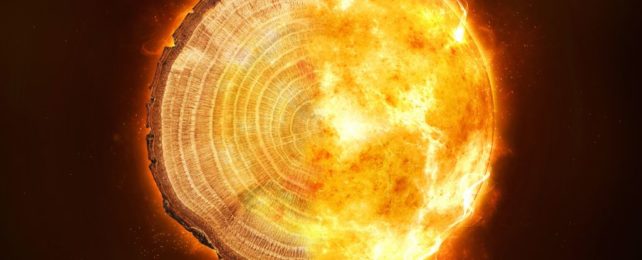The history of Earth's bombardment with cosmic radiation is written in the trees.
Specifically, when radiation slams into Earth's atmosphere, it can alter any nitrogen atoms it slams into to produce a form of carbon, which is in turn absorbed by plants. Linking spikes in this carbon isotope with the growth rings in trees can give us a reliable record of radiation storms going back thousands of years.
This record shows us that the most colossal of these events, known as Miyake events (after the scientist who discovered them), occur around once every thousand years. However, we don't know what causes them – and new research suggests that our leading theory, involving giant solar flares, could be off the table.
Without an easy way to predict these potentially devastating events, we're left with a serious problem.
"We need to know more, because if one of these happened today, it would destroy technology including satellites, internet cables, long-distance power lines and transformers," says astrophysicist Benjamin Pope of the University of Queensland in Australia.
"The effect on global infrastructure would be unimaginable."
The history of Earth's encounters with storms of cosmic radiation is there to decipher if you know how to look. The main clue is a radioactive isotope of carbon called carbon-14, often referred to as radiocarbon. Compared to other naturally occurring isotopes of carbon on Earth, radiocarbon is relatively scarce. It forms only in the upper atmosphere, when cosmic rays collide with nitrogen atoms, triggering a nuclear reaction that creates radiocarbon.
Because cosmic rays are constantly colliding with our atmosphere, we have a constant but very small supply of the stuff raining down on the surface. Some of it gets caught up in tree rings. Since trees add a new growth ring every year, the radiocarbon deposition can be traced back through time, giving a record of radiation activity over tens of millennia.
A large spike in radiocarbon found in trees around the world means an uptick in cosmic radiation. There are several mechanisms that can cause this, and solar flares are a big one. But there are some other possible sources of radiation storms that haven't been conclusively ruled out. Nor have solar flares been conclusively ruled in.
Because interpreting tree ring data necessitates a comprehensive understanding of the global carbon cycle, a team of researchers led by mathematician Qingyuan Zhang of the University of Queensland set about reconstructing the global carbon cycle, based on every scrap of tree ring radiocarbon data they could get their hands on.
"When radiation strikes the atmosphere it produces radioactive carbon-14, which filters through the air, oceans, plants, and animals, and produces an annual record of radiation in tree rings," Zhang explains.
"We modeled the global carbon cycle to reconstruct the process over a 10,000-year period, to gain insight into the scale and nature of the Miyake events."
The results of this modeling gave the team an extremely detailed picture of a number of radiation events – enough to conclude that the timing and profile is inconsistent with solar flares. The spikes in radiocarbon do not correlate with sunspot activity, which is itself linked with flare activity. Some spikes persisted across multiple years.
And there was inconsistency in the radiocarbon profiles between regions for the same event. For one major event, recorded in 774 CE, some trees in some parts of the world showed sharp, sudden rises in radiocarbon for one year, while others showed a slower spike across two to three years.
"Rather than a single instantaneous explosion or flare, what we may be looking at is a kind of astrophysical 'storm' or outburst," Zhang says.
The researchers don't know, at this point, what might be causing those outbursts, but there are a number of candidates. One of those is supernova events, the radiation from which can blast across space. A supernova possibly did take place in 774 CE, and scientists have made links between radiocarbon spikes and other possible supernova events, but we have known supernovae with no radiocarbon spikes, and spikes with no linked supernovae.
Other potential causes include solar superflares, but a flare powerful enough to produce the 774 CE radiocarbon spike is unlikely to have erupted from our Sun. Perhaps there's some previously unrecorded solar activity. But the fact is, there's no simple explanation that neatly explains what causes Miyake events.
And this, according to the researchers, is a worry. The human world has changed dramatically since 774 CE; a Miyake event now could cause what the scientists call an "internet apocalypse" as infrastructure gets damaged, harm the health of air travelers, and even deplete the ozone layer.
"Based on available data, there's roughly a one percent chance of seeing another one within the next decade," Pope says.
"But we don't know how to predict it or what harms it may cause. These odds are quite alarming, and lay the foundation for further research."
The research has been published in Proceedings of the Royal Society A: Mathematical, Physical, and Engineering Sciences.
